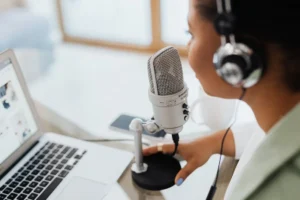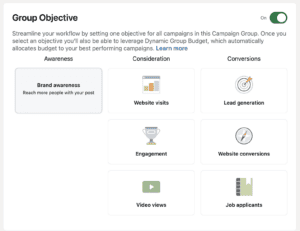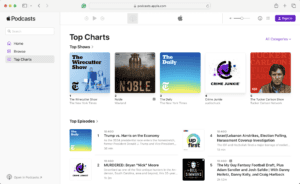Wondering how the World responds to podcasting? Looking for podcast statistics, industry stats, and listener data?
True Fact: Podcasting is no longer in the shadows of other forms of audio content. With Podcast Insights reporting over 850 million shows available on Apple Podcasts, the industry shows no signs of slowing down.
With that growth comes studies and reports to track where we’ve been and where we’re headed. Sources like Edison Research and Triton Digital contributing to The Infinite Dial research and Share of Ear reports, there are a lot of podcast statistics to keep track of.
So we’ve combed the web for every major figure, graph, statistic, and data point about podcasting. From industry statistics, listener trends, and advertising effectiveness, this is every podcast statistic you need to know in 2020.
We’ll update this piece regularly with the latest information. Here are the most current data points as of October 2020.
Also, don’t forget to listen to our Audience episode with Tom Webster from Edison Research. He gives us a no-nonsense look at new podcast statistics due to COVID-19 and what it means for the industry.
Action
Read to start your own podcast? Learn the nitty-gritty details of starting your own show in our comprehensive guide. Learn how to start a podcast.
Podcast Industry Statistics
As of 2020, podcasts have officially entered the main stream. Below are at look at some podcast statistics that reflect the growth and health of the industry overall:
- 197 million Americans are familiar with podcasting in 2020. (Infinite Dial Report 2020)
- 43% of the U.S. population 13+ listen daily to spoken word audio. This includes podcasts, news, sports, talk radio and audiobooks. (Spoken Word Audio Report, 2020)
- And 144 million Americans (51% of the population) reported to listening to podcast in 2019. That’s 20 million more people than in 2018. (Infinite Dial Report 2020)
- 32% of the US population listens to a podcast on a monthly basis. That’s 17 million more people compared to 2018.(Infinite Dial Report 2020)
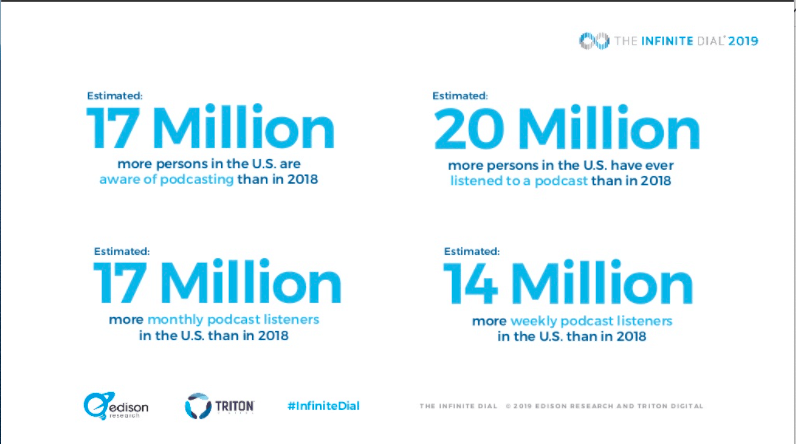
- The COVID-19 pandemic has impacted spoken audio consumption where 40% of respondents say they’re listening more since quarantine restrictions. (Spoken Word Audio Report, 2020)
- Pandora is the most highly recognized audio brand for the US population ages 12+. Followed in order by iHeart Radio, Amazon Music, Apple Music, and Spotify. (Infinite Dial Report 2020)
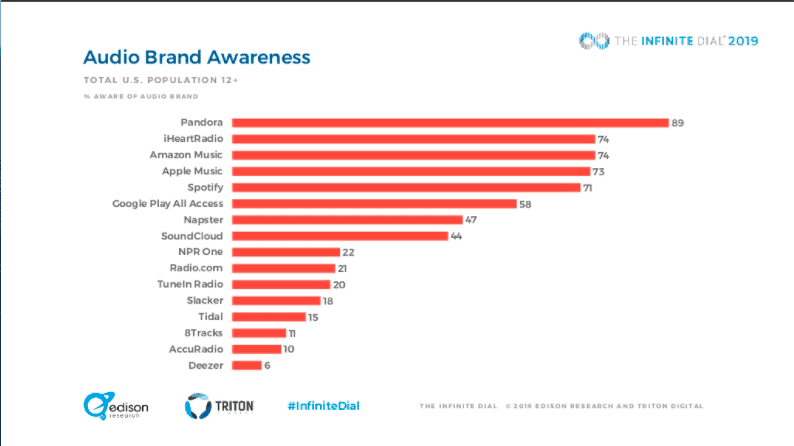
- However, Pandora and Spotify are the most widely used platforms. 30% of the US population listened on Pandora within the last month and 24% used Spotify. There are dramatic increases from the 12% who used Apple Music and 13% who used iHeartRadio. (Infinite Dial Report 2020)
- In Apple’s Top 200 Chart, 25% of the listed podcasts are within the Society and Culture category. (Pacific Content, 2020)
- Music, news/information, and entertainment/celebrity/gossip are the top 3 categories topics listeners are most interested in. (Podcast Consumer Report, 2019)
- Listeners reported searching the internet, social media, getting recommendations from friends and family, and recommendations from other podcast hosts as the primary ways they discover podcasts. (Podcast Consumer Report, 2019)
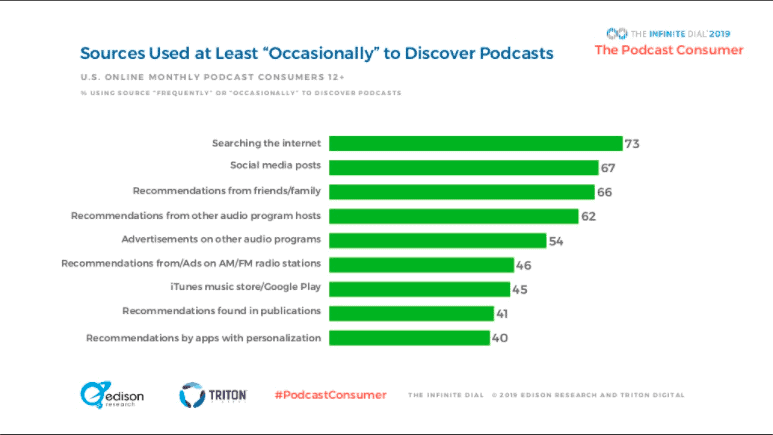
Podcast Listening Trends
Podcasting is an industry made up of two sides, the creators and the consumers. Below are key listening trends from Edison Research, Triton Digital, and a few more sources:
- The two biggest reasons people don’t listen to podcasts is “they just aren’t for me” (75% of respondents) and “I don’t have enough time to listen to podcasts”. (Podcast Consumer Report, 2019)
- Of podcast listeners, the primary reason they consume them is to “learn new things”, “be entertained”, and “stay up-to-date with latest topics. (Podcast Consumer Report, 2019)
- Average time spent listening to podcasts was 6 hours and 15 minutes in Q1 2020. This increased to 6 hours and 23 minutes as of May 12, 2020. (Share of Ear Report, 2020)
- The top 3 podcasts in the U.S. for most weekly podcast listeners include The Joe Rogan Experience, The Daily, and This American Life. (Podcast Consumer Report 2020)
- 36% of the male population and 29% of females reported monthly podcast listening in 2019. As podcasting entered the mainstream, we saw these percentages rise from 27% for males and 24% for females in 2018. (Infinite Dial Report 2020)
- Listeners ages 12-24 and 25-54 account for the majority of podcast listeners, with the 55+ demographic coming in last. However, each age bracket has reported increased monthly podcast listening since 2017. (Infinite Dial Report 2020)
- The device most often used to listen to podcasts are smartphones and tablets, followed by computers/laptops, and last is smart speakers. (Podcast Consumer Report, 2019)
- 30% of all audio listening on smartphones goes to spoken word audio. (Spoken Word Audio Report, 2020)
- Pacific Content reports web-based listeners (those who listen to episodes via a web browser), are less likely to complete a whole episode. Compared to a listener who tunes in via a listening app like Spotify or Apple Podcasts. (Pacific Content, 2020)
- Podcast listeners in America reported they begin listening to audio content between 7:15am and 8:30am. This is likely due to common commuting hours. (Share of Ear Report, 2020)
- 26% of drivers in the US listen to podcasts while in the car as of 2019. This is up from 23% in 2018 and 19% in 2017. (Infinite Dial Report 2020)
- Respondents aged 12-34 prefer Spotify as their audio listening platform over any other brand. (Infinite Dial Report 2020)
- US weekly podcast listeners average 7 podcasts per week. (Infinite Dial Report 2020)
- Podcast listeners primarily tune in while at home, in a car or truck, or while walking around. Listening while at working out, at work, or riding public transportation are other popular locations. (Podcast Consumer Report, 2019)
- While tuning in, respondents reported that they don’t do anything else while listening to a podcast (70% of listeners), do housework or chores (59%), or are driving while listening (52%). (Podcast Consumer Report, 2019)
- The above two podcast statistics are interesting because the same group of respondents reported they enjoy listening to podcasts because “I can do other things while listening” and “they are portable”. (Podcast Consumer Report, 2019)
- After downloading a new podcast episode, 47% of listeners consume the content within 24 hours. And 31% listen within 48 hours. (Podcast Consumer Report, 2019)
- Over 50% of podcast listeners report listening to an entire podcast episode. This is compared to the 5% of listeners who consume less than half. (Podcast Consumer Report, 2019)
- 26% of podcast listeners increase the playback speed of an episode. (Podcast Consumer Report, 2019)
- Most listeners judge podcasts based on their description and then their title. (The Podcast Host’s Podcast Discovery Survey)
Podcast Content Statistics
- The median episode duration is 38 minutes and 42 seconds. (Pacific Content)
- The average American’s commute, a popular listening time, is 26.4 minutes. (Census.gov)
- 46% of listeners consume a full episode, with the 18-30 minute range being the sweet spot for completion. (Nick DePrey)
Podcast Advertising Statistics
As more people consume podcasts, the advertising dollars will follow. Here are some interesting figures and statistics related to the effectiveness of podcast ads:
- 54% of podcast consumers say that they are more likely to consider the brands they hear advertised on podcasts (Podcast Consumer Report, 2019)
- The majority of monthly podcast consumers have an average household income between $100K-$150K. (Podcast Consumer Report, 2019)
- In a survey of nearly 1,000 podcast listeners, conducted in partnership with Edison Research, it was found that nearly two-thirds (65%) of fans are more willing to consider purchasing products and services they learn about during a podcast. Sixty percent also state that, given equal price and quality, they prefer to buy products from companies that advertise on their favorite podcasts. (IAB-Edison Research Podcast Advertising Study, 2016)
- Podcast advertising drives brand recall among listeners, where advertised products can see as much as a 16% increase in recognition after being exposed to podcast ads. (PodcastOne Edison Research Brand Lift Study, 2016)
- Podcast ads also aid in messaging recall where respondents recognized “were you aware that [product benefit claim]?” 25-32% more after hearing an ad. (PodcastOne Edison Research Brand Lift Study, 2016)
Podcast Statistics – What’s Next?
The podcast industry is on the rise, and doesn’t show any signs of stopping. We’ll continue to update this article with the most up-to-date information as it’s reported and include new studies as we find them. If there are podcast statistics you would like to see included, drop them in the comments below.

